The Relationship between Consumption of Coffee and Tea and Endometrial Cancer Risk
VerifiedAdded on 2023/06/03
|11
|3173
|57
AI Summary
A study done on the relationship between consumption of tea and coffee and risk of getting Endometrial Cancer shows that some life practices reduce the probability of getting the disease. The findings and results from the study show that by taking some amount of coffee and tea on daily basis, one reduces the risks of getting the disease.
Contribute Materials
Your contribution can guide someone’s learning journey. Share your
documents today.
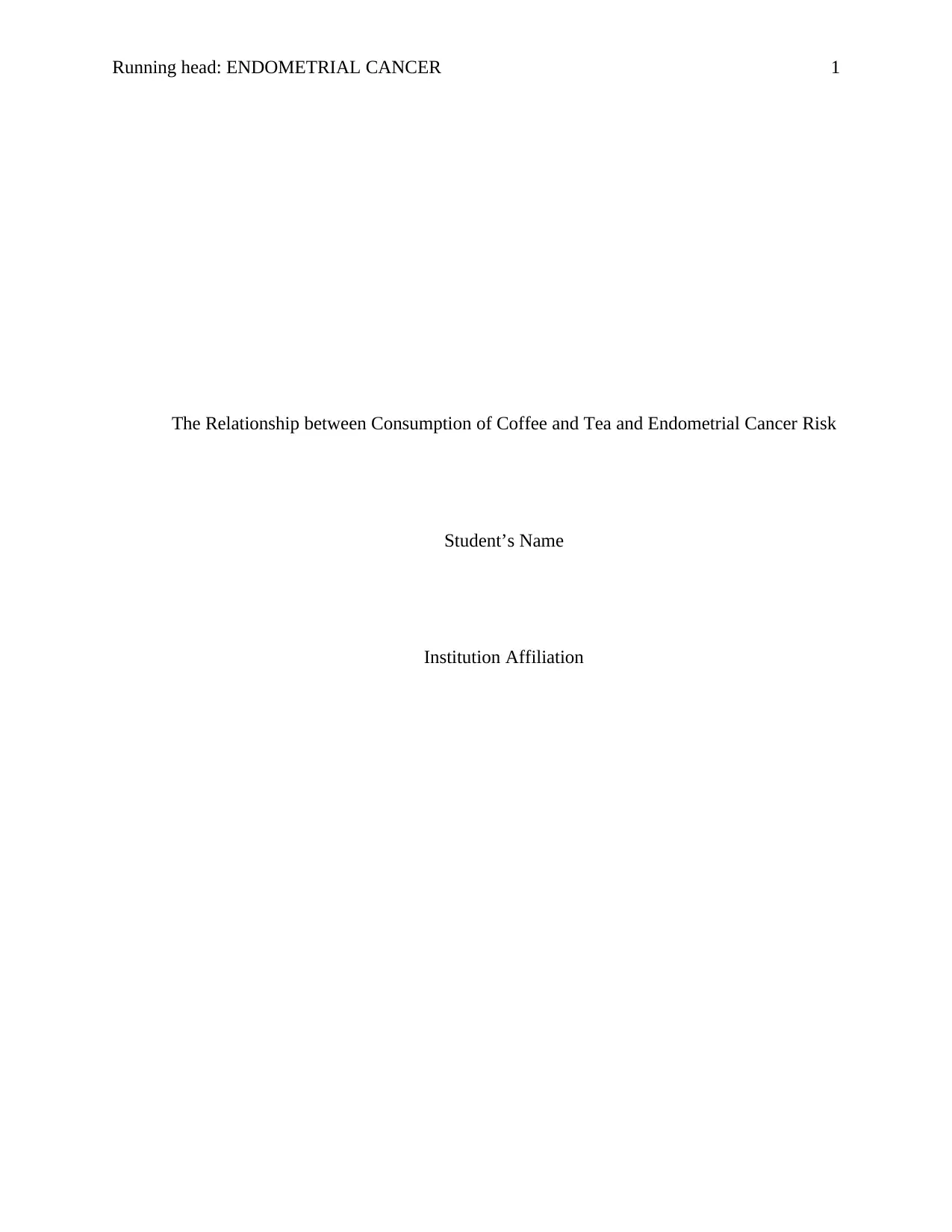
Running head: ENDOMETRIAL CANCER 1
The Relationship between Consumption of Coffee and Tea and Endometrial Cancer Risk
Student’s Name
Institution Affiliation
The Relationship between Consumption of Coffee and Tea and Endometrial Cancer Risk
Student’s Name
Institution Affiliation
Secure Best Marks with AI Grader
Need help grading? Try our AI Grader for instant feedback on your assignments.
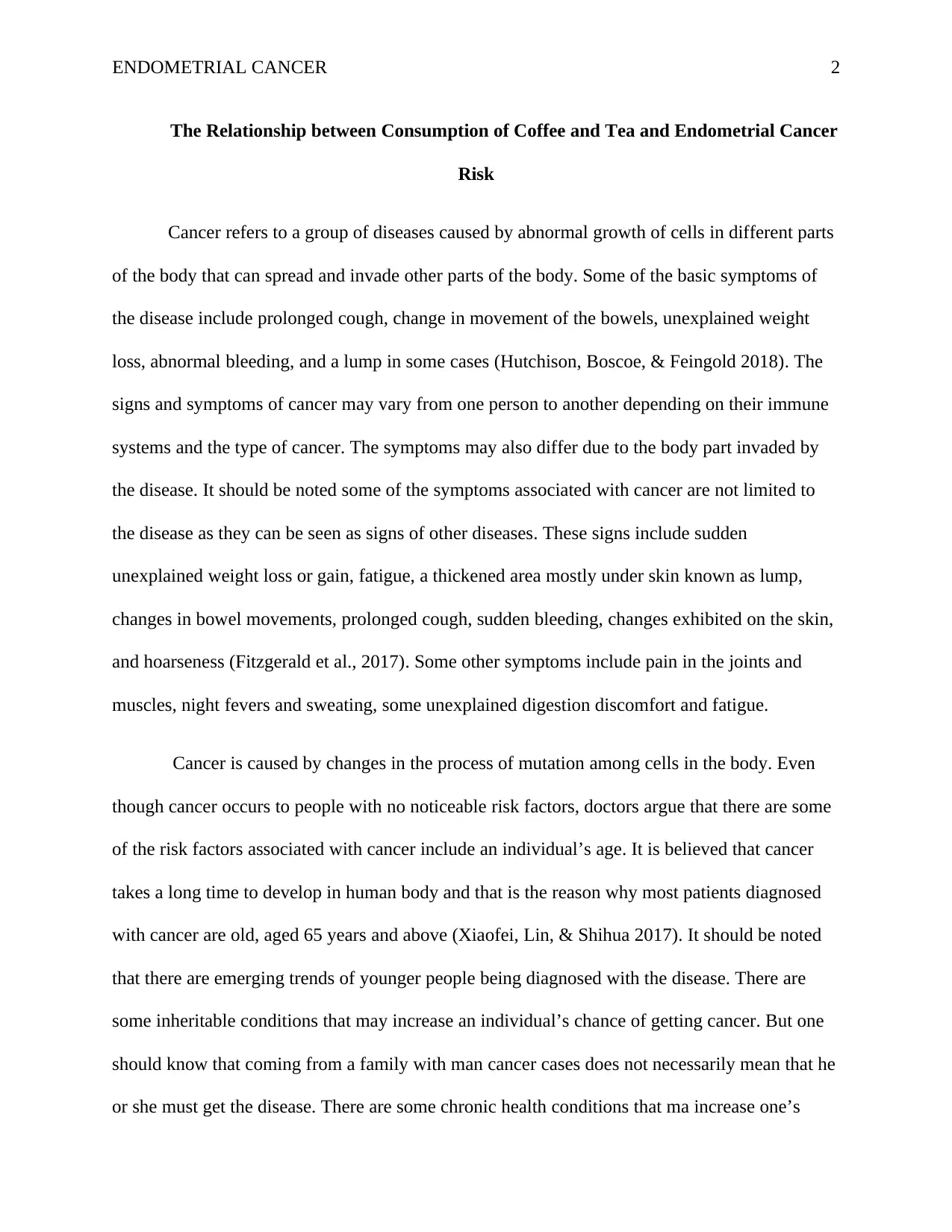
ENDOMETRIAL CANCER 2
The Relationship between Consumption of Coffee and Tea and Endometrial Cancer
Risk
Cancer refers to a group of diseases caused by abnormal growth of cells in different parts
of the body that can spread and invade other parts of the body. Some of the basic symptoms of
the disease include prolonged cough, change in movement of the bowels, unexplained weight
loss, abnormal bleeding, and a lump in some cases (Hutchison, Boscoe, & Feingold 2018). The
signs and symptoms of cancer may vary from one person to another depending on their immune
systems and the type of cancer. The symptoms may also differ due to the body part invaded by
the disease. It should be noted some of the symptoms associated with cancer are not limited to
the disease as they can be seen as signs of other diseases. These signs include sudden
unexplained weight loss or gain, fatigue, a thickened area mostly under skin known as lump,
changes in bowel movements, prolonged cough, sudden bleeding, changes exhibited on the skin,
and hoarseness (Fitzgerald et al., 2017). Some other symptoms include pain in the joints and
muscles, night fevers and sweating, some unexplained digestion discomfort and fatigue.
Cancer is caused by changes in the process of mutation among cells in the body. Even
though cancer occurs to people with no noticeable risk factors, doctors argue that there are some
of the risk factors associated with cancer include an individual’s age. It is believed that cancer
takes a long time to develop in human body and that is the reason why most patients diagnosed
with cancer are old, aged 65 years and above (Xiaofei, Lin, & Shihua 2017). It should be noted
that there are emerging trends of younger people being diagnosed with the disease. There are
some inheritable conditions that may increase an individual’s chance of getting cancer. But one
should know that coming from a family with man cancer cases does not necessarily mean that he
or she must get the disease. There are some chronic health conditions that ma increase one’s
The Relationship between Consumption of Coffee and Tea and Endometrial Cancer
Risk
Cancer refers to a group of diseases caused by abnormal growth of cells in different parts
of the body that can spread and invade other parts of the body. Some of the basic symptoms of
the disease include prolonged cough, change in movement of the bowels, unexplained weight
loss, abnormal bleeding, and a lump in some cases (Hutchison, Boscoe, & Feingold 2018). The
signs and symptoms of cancer may vary from one person to another depending on their immune
systems and the type of cancer. The symptoms may also differ due to the body part invaded by
the disease. It should be noted some of the symptoms associated with cancer are not limited to
the disease as they can be seen as signs of other diseases. These signs include sudden
unexplained weight loss or gain, fatigue, a thickened area mostly under skin known as lump,
changes in bowel movements, prolonged cough, sudden bleeding, changes exhibited on the skin,
and hoarseness (Fitzgerald et al., 2017). Some other symptoms include pain in the joints and
muscles, night fevers and sweating, some unexplained digestion discomfort and fatigue.
Cancer is caused by changes in the process of mutation among cells in the body. Even
though cancer occurs to people with no noticeable risk factors, doctors argue that there are some
of the risk factors associated with cancer include an individual’s age. It is believed that cancer
takes a long time to develop in human body and that is the reason why most patients diagnosed
with cancer are old, aged 65 years and above (Xiaofei, Lin, & Shihua 2017). It should be noted
that there are emerging trends of younger people being diagnosed with the disease. There are
some inheritable conditions that may increase an individual’s chance of getting cancer. But one
should know that coming from a family with man cancer cases does not necessarily mean that he
or she must get the disease. There are some chronic health conditions that ma increase one’s
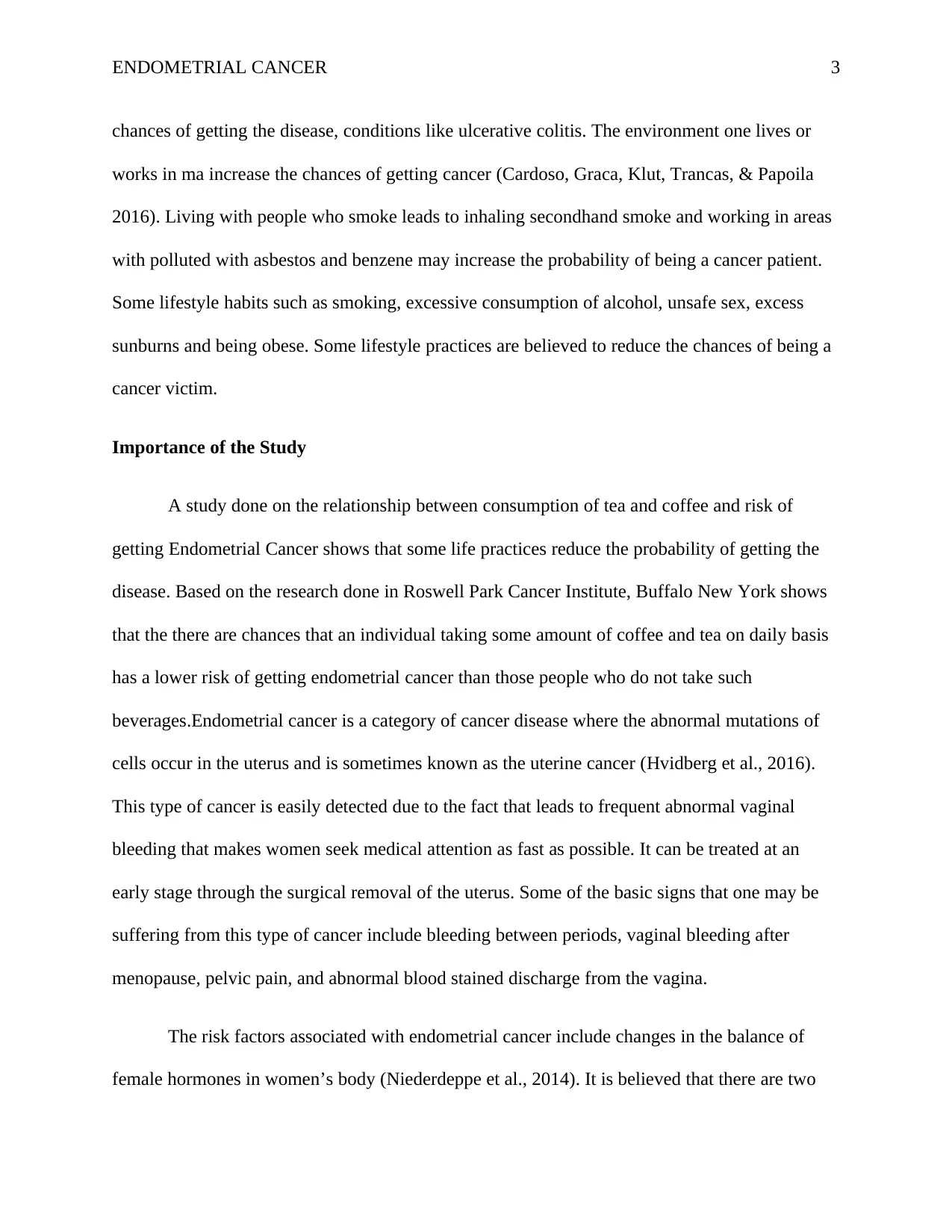
ENDOMETRIAL CANCER 3
chances of getting the disease, conditions like ulcerative colitis. The environment one lives or
works in ma increase the chances of getting cancer (Cardoso, Graca, Klut, Trancas, & Papoila
2016). Living with people who smoke leads to inhaling secondhand smoke and working in areas
with polluted with asbestos and benzene may increase the probability of being a cancer patient.
Some lifestyle habits such as smoking, excessive consumption of alcohol, unsafe sex, excess
sunburns and being obese. Some lifestyle practices are believed to reduce the chances of being a
cancer victim.
Importance of the Study
A study done on the relationship between consumption of tea and coffee and risk of
getting Endometrial Cancer shows that some life practices reduce the probability of getting the
disease. Based on the research done in Roswell Park Cancer Institute, Buffalo New York shows
that the there are chances that an individual taking some amount of coffee and tea on daily basis
has a lower risk of getting endometrial cancer than those people who do not take such
beverages.Endometrial cancer is a category of cancer disease where the abnormal mutations of
cells occur in the uterus and is sometimes known as the uterine cancer (Hvidberg et al., 2016).
This type of cancer is easily detected due to the fact that leads to frequent abnormal vaginal
bleeding that makes women seek medical attention as fast as possible. It can be treated at an
early stage through the surgical removal of the uterus. Some of the basic signs that one may be
suffering from this type of cancer include bleeding between periods, vaginal bleeding after
menopause, pelvic pain, and abnormal blood stained discharge from the vagina.
The risk factors associated with endometrial cancer include changes in the balance of
female hormones in women’s body (Niederdeppe et al., 2014). It is believed that there are two
chances of getting the disease, conditions like ulcerative colitis. The environment one lives or
works in ma increase the chances of getting cancer (Cardoso, Graca, Klut, Trancas, & Papoila
2016). Living with people who smoke leads to inhaling secondhand smoke and working in areas
with polluted with asbestos and benzene may increase the probability of being a cancer patient.
Some lifestyle habits such as smoking, excessive consumption of alcohol, unsafe sex, excess
sunburns and being obese. Some lifestyle practices are believed to reduce the chances of being a
cancer victim.
Importance of the Study
A study done on the relationship between consumption of tea and coffee and risk of
getting Endometrial Cancer shows that some life practices reduce the probability of getting the
disease. Based on the research done in Roswell Park Cancer Institute, Buffalo New York shows
that the there are chances that an individual taking some amount of coffee and tea on daily basis
has a lower risk of getting endometrial cancer than those people who do not take such
beverages.Endometrial cancer is a category of cancer disease where the abnormal mutations of
cells occur in the uterus and is sometimes known as the uterine cancer (Hvidberg et al., 2016).
This type of cancer is easily detected due to the fact that leads to frequent abnormal vaginal
bleeding that makes women seek medical attention as fast as possible. It can be treated at an
early stage through the surgical removal of the uterus. Some of the basic signs that one may be
suffering from this type of cancer include bleeding between periods, vaginal bleeding after
menopause, pelvic pain, and abnormal blood stained discharge from the vagina.
The risk factors associated with endometrial cancer include changes in the balance of
female hormones in women’s body (Niederdeppe et al., 2014). It is believed that there are two
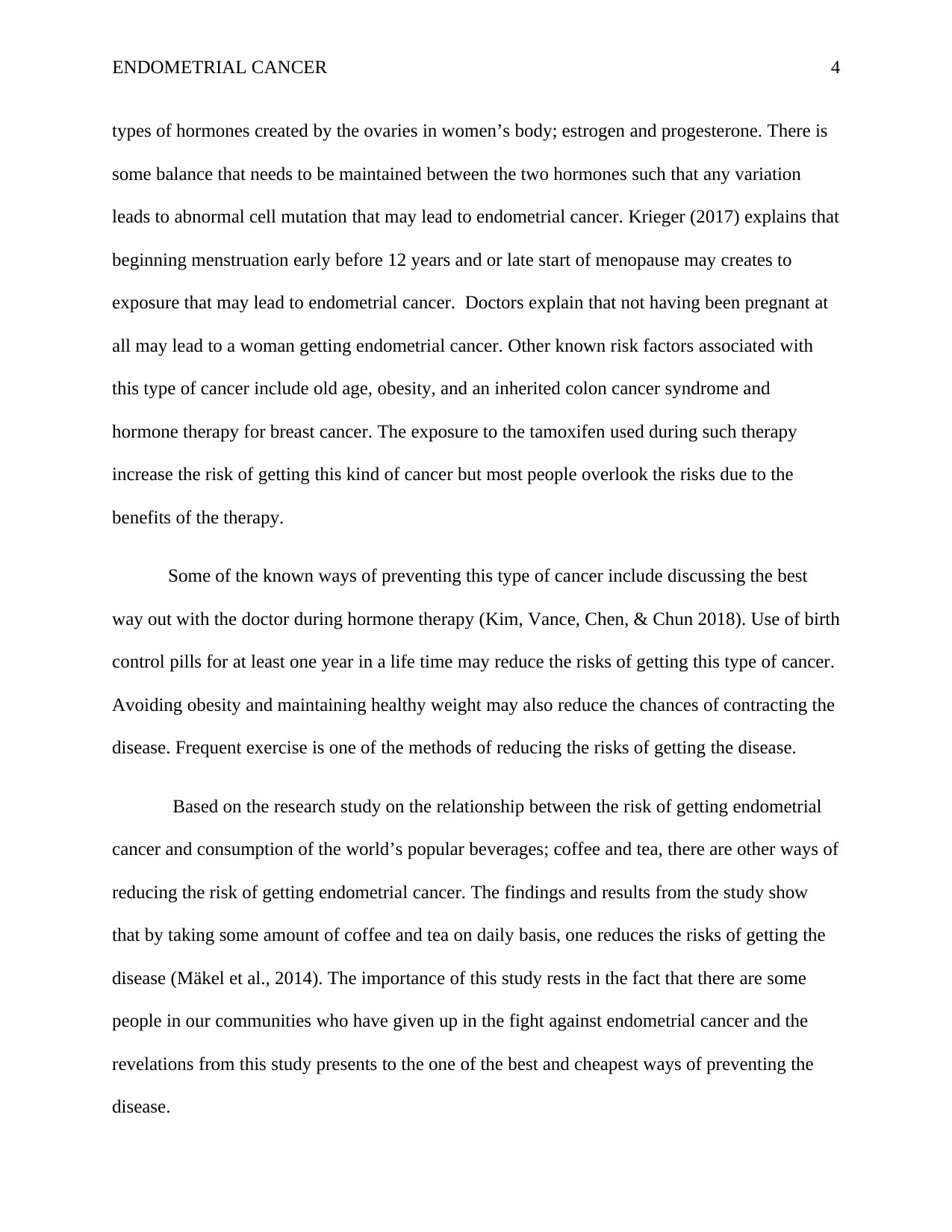
ENDOMETRIAL CANCER 4
types of hormones created by the ovaries in women’s body; estrogen and progesterone. There is
some balance that needs to be maintained between the two hormones such that any variation
leads to abnormal cell mutation that may lead to endometrial cancer. Krieger (2017) explains that
beginning menstruation early before 12 years and or late start of menopause may creates to
exposure that may lead to endometrial cancer. Doctors explain that not having been pregnant at
all may lead to a woman getting endometrial cancer. Other known risk factors associated with
this type of cancer include old age, obesity, and an inherited colon cancer syndrome and
hormone therapy for breast cancer. The exposure to the tamoxifen used during such therapy
increase the risk of getting this kind of cancer but most people overlook the risks due to the
benefits of the therapy.
Some of the known ways of preventing this type of cancer include discussing the best
way out with the doctor during hormone therapy (Kim, Vance, Chen, & Chun 2018). Use of birth
control pills for at least one year in a life time may reduce the risks of getting this type of cancer.
Avoiding obesity and maintaining healthy weight may also reduce the chances of contracting the
disease. Frequent exercise is one of the methods of reducing the risks of getting the disease.
Based on the research study on the relationship between the risk of getting endometrial
cancer and consumption of the world’s popular beverages; coffee and tea, there are other ways of
reducing the risk of getting endometrial cancer. The findings and results from the study show
that by taking some amount of coffee and tea on daily basis, one reduces the risks of getting the
disease (Mäkel et al., 2014). The importance of this study rests in the fact that there are some
people in our communities who have given up in the fight against endometrial cancer and the
revelations from this study presents to the one of the best and cheapest ways of preventing the
disease.
types of hormones created by the ovaries in women’s body; estrogen and progesterone. There is
some balance that needs to be maintained between the two hormones such that any variation
leads to abnormal cell mutation that may lead to endometrial cancer. Krieger (2017) explains that
beginning menstruation early before 12 years and or late start of menopause may creates to
exposure that may lead to endometrial cancer. Doctors explain that not having been pregnant at
all may lead to a woman getting endometrial cancer. Other known risk factors associated with
this type of cancer include old age, obesity, and an inherited colon cancer syndrome and
hormone therapy for breast cancer. The exposure to the tamoxifen used during such therapy
increase the risk of getting this kind of cancer but most people overlook the risks due to the
benefits of the therapy.
Some of the known ways of preventing this type of cancer include discussing the best
way out with the doctor during hormone therapy (Kim, Vance, Chen, & Chun 2018). Use of birth
control pills for at least one year in a life time may reduce the risks of getting this type of cancer.
Avoiding obesity and maintaining healthy weight may also reduce the chances of contracting the
disease. Frequent exercise is one of the methods of reducing the risks of getting the disease.
Based on the research study on the relationship between the risk of getting endometrial
cancer and consumption of the world’s popular beverages; coffee and tea, there are other ways of
reducing the risk of getting endometrial cancer. The findings and results from the study show
that by taking some amount of coffee and tea on daily basis, one reduces the risks of getting the
disease (Mäkel et al., 2014). The importance of this study rests in the fact that there are some
people in our communities who have given up in the fight against endometrial cancer and the
revelations from this study presents to the one of the best and cheapest ways of preventing the
disease.
Secure Best Marks with AI Grader
Need help grading? Try our AI Grader for instant feedback on your assignments.
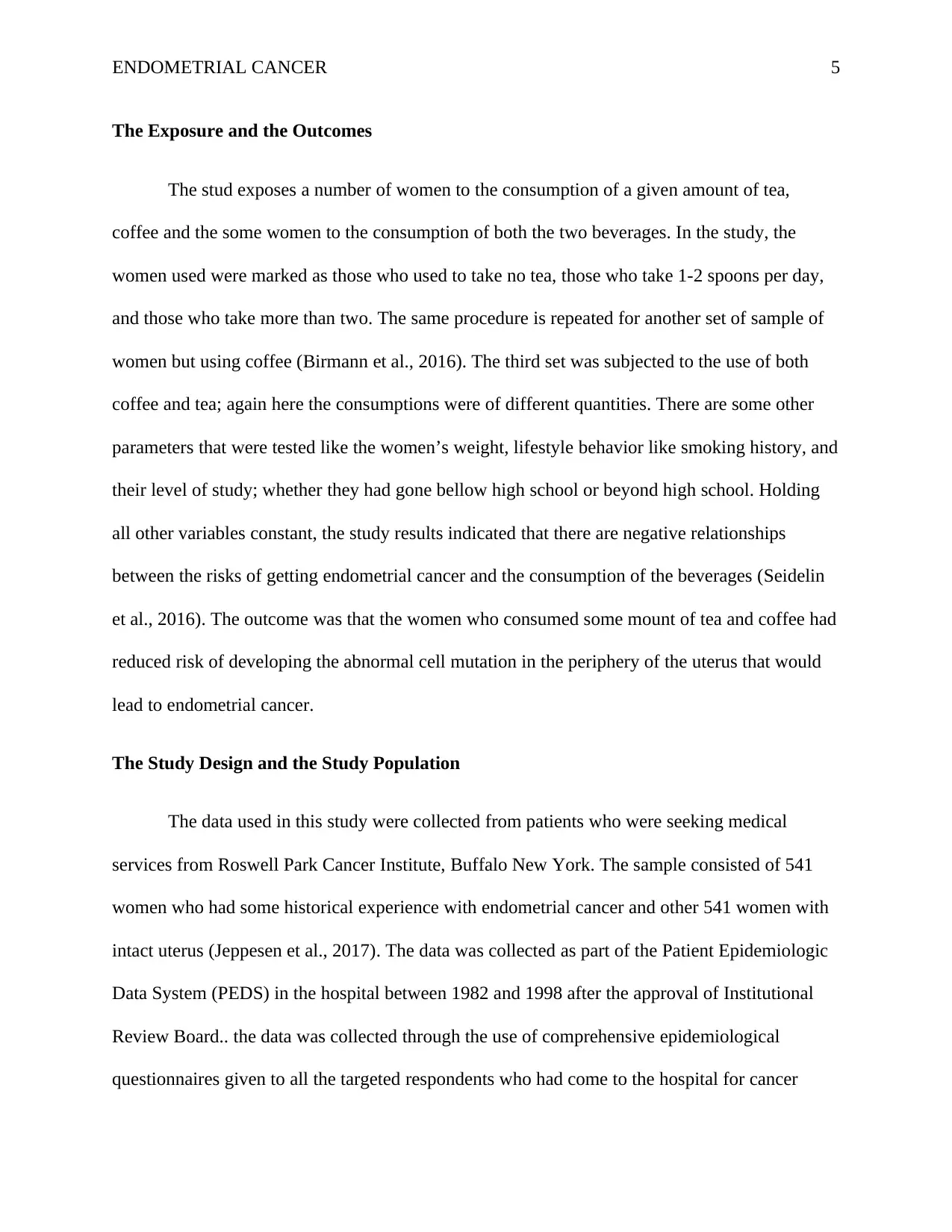
ENDOMETRIAL CANCER 5
The Exposure and the Outcomes
The stud exposes a number of women to the consumption of a given amount of tea,
coffee and the some women to the consumption of both the two beverages. In the study, the
women used were marked as those who used to take no tea, those who take 1-2 spoons per day,
and those who take more than two. The same procedure is repeated for another set of sample of
women but using coffee (Birmann et al., 2016). The third set was subjected to the use of both
coffee and tea; again here the consumptions were of different quantities. There are some other
parameters that were tested like the women’s weight, lifestyle behavior like smoking history, and
their level of study; whether they had gone bellow high school or beyond high school. Holding
all other variables constant, the study results indicated that there are negative relationships
between the risks of getting endometrial cancer and the consumption of the beverages (Seidelin
et al., 2016). The outcome was that the women who consumed some mount of tea and coffee had
reduced risk of developing the abnormal cell mutation in the periphery of the uterus that would
lead to endometrial cancer.
The Study Design and the Study Population
The data used in this study were collected from patients who were seeking medical
services from Roswell Park Cancer Institute, Buffalo New York. The sample consisted of 541
women who had some historical experience with endometrial cancer and other 541 women with
intact uterus (Jeppesen et al., 2017). The data was collected as part of the Patient Epidemiologic
Data System (PEDS) in the hospital between 1982 and 1998 after the approval of Institutional
Review Board.. the data was collected through the use of comprehensive epidemiological
questionnaires given to all the targeted respondents who had come to the hospital for cancer
The Exposure and the Outcomes
The stud exposes a number of women to the consumption of a given amount of tea,
coffee and the some women to the consumption of both the two beverages. In the study, the
women used were marked as those who used to take no tea, those who take 1-2 spoons per day,
and those who take more than two. The same procedure is repeated for another set of sample of
women but using coffee (Birmann et al., 2016). The third set was subjected to the use of both
coffee and tea; again here the consumptions were of different quantities. There are some other
parameters that were tested like the women’s weight, lifestyle behavior like smoking history, and
their level of study; whether they had gone bellow high school or beyond high school. Holding
all other variables constant, the study results indicated that there are negative relationships
between the risks of getting endometrial cancer and the consumption of the beverages (Seidelin
et al., 2016). The outcome was that the women who consumed some mount of tea and coffee had
reduced risk of developing the abnormal cell mutation in the periphery of the uterus that would
lead to endometrial cancer.
The Study Design and the Study Population
The data used in this study were collected from patients who were seeking medical
services from Roswell Park Cancer Institute, Buffalo New York. The sample consisted of 541
women who had some historical experience with endometrial cancer and other 541 women with
intact uterus (Jeppesen et al., 2017). The data was collected as part of the Patient Epidemiologic
Data System (PEDS) in the hospital between 1982 and 1998 after the approval of Institutional
Review Board.. the data was collected through the use of comprehensive epidemiological
questionnaires given to all the targeted respondents who had come to the hospital for cancer
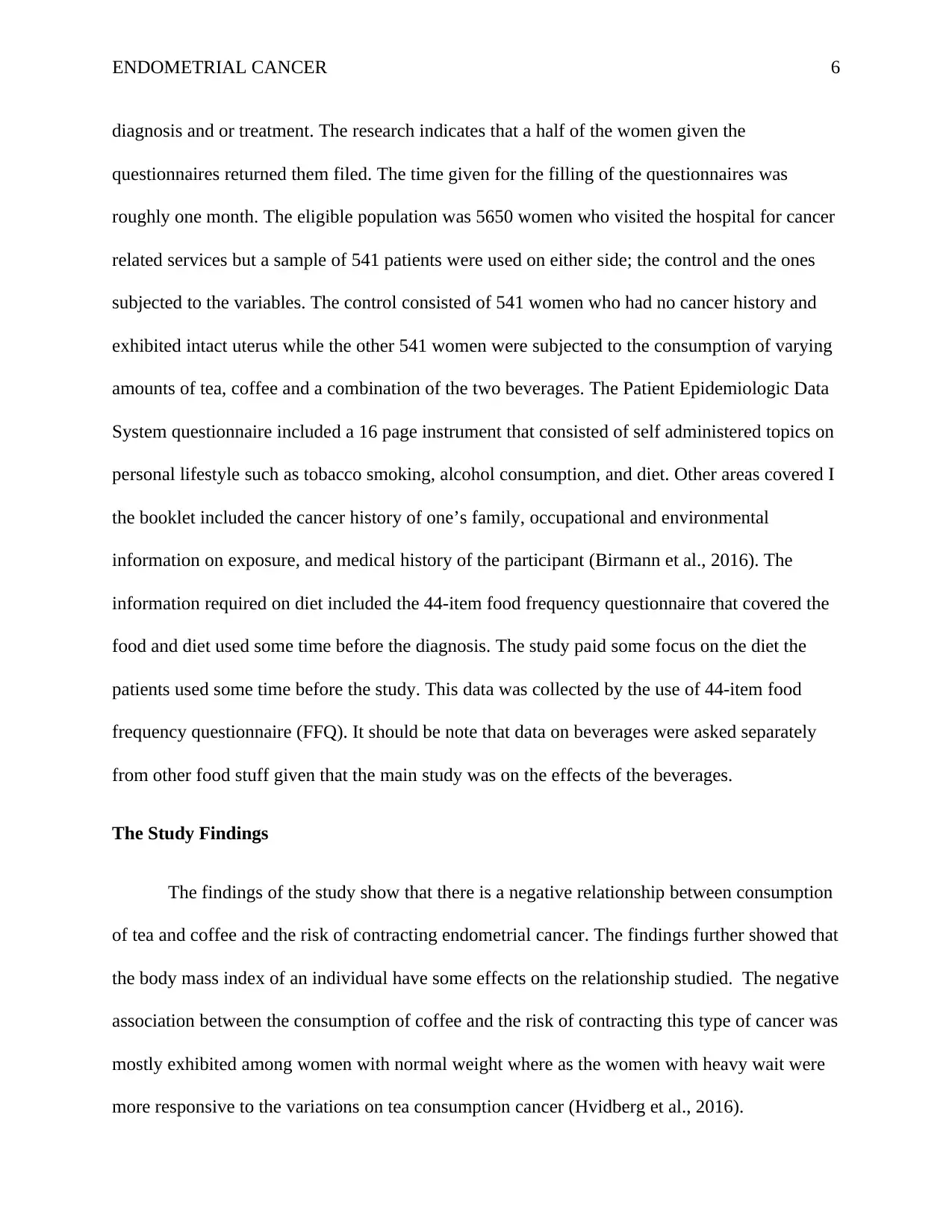
ENDOMETRIAL CANCER 6
diagnosis and or treatment. The research indicates that a half of the women given the
questionnaires returned them filed. The time given for the filling of the questionnaires was
roughly one month. The eligible population was 5650 women who visited the hospital for cancer
related services but a sample of 541 patients were used on either side; the control and the ones
subjected to the variables. The control consisted of 541 women who had no cancer history and
exhibited intact uterus while the other 541 women were subjected to the consumption of varying
amounts of tea, coffee and a combination of the two beverages. The Patient Epidemiologic Data
System questionnaire included a 16 page instrument that consisted of self administered topics on
personal lifestyle such as tobacco smoking, alcohol consumption, and diet. Other areas covered I
the booklet included the cancer history of one’s family, occupational and environmental
information on exposure, and medical history of the participant (Birmann et al., 2016). The
information required on diet included the 44-item food frequency questionnaire that covered the
food and diet used some time before the diagnosis. The study paid some focus on the diet the
patients used some time before the study. This data was collected by the use of 44-item food
frequency questionnaire (FFQ). It should be note that data on beverages were asked separately
from other food stuff given that the main study was on the effects of the beverages.
The Study Findings
The findings of the study show that there is a negative relationship between consumption
of tea and coffee and the risk of contracting endometrial cancer. The findings further showed that
the body mass index of an individual have some effects on the relationship studied. The negative
association between the consumption of coffee and the risk of contracting this type of cancer was
mostly exhibited among women with normal weight where as the women with heavy wait were
more responsive to the variations on tea consumption cancer (Hvidberg et al., 2016).
diagnosis and or treatment. The research indicates that a half of the women given the
questionnaires returned them filed. The time given for the filling of the questionnaires was
roughly one month. The eligible population was 5650 women who visited the hospital for cancer
related services but a sample of 541 patients were used on either side; the control and the ones
subjected to the variables. The control consisted of 541 women who had no cancer history and
exhibited intact uterus while the other 541 women were subjected to the consumption of varying
amounts of tea, coffee and a combination of the two beverages. The Patient Epidemiologic Data
System questionnaire included a 16 page instrument that consisted of self administered topics on
personal lifestyle such as tobacco smoking, alcohol consumption, and diet. Other areas covered I
the booklet included the cancer history of one’s family, occupational and environmental
information on exposure, and medical history of the participant (Birmann et al., 2016). The
information required on diet included the 44-item food frequency questionnaire that covered the
food and diet used some time before the diagnosis. The study paid some focus on the diet the
patients used some time before the study. This data was collected by the use of 44-item food
frequency questionnaire (FFQ). It should be note that data on beverages were asked separately
from other food stuff given that the main study was on the effects of the beverages.
The Study Findings
The findings of the study show that there is a negative relationship between consumption
of tea and coffee and the risk of contracting endometrial cancer. The findings further showed that
the body mass index of an individual have some effects on the relationship studied. The negative
association between the consumption of coffee and the risk of contracting this type of cancer was
mostly exhibited among women with normal weight where as the women with heavy wait were
more responsive to the variations on tea consumption cancer (Hvidberg et al., 2016).
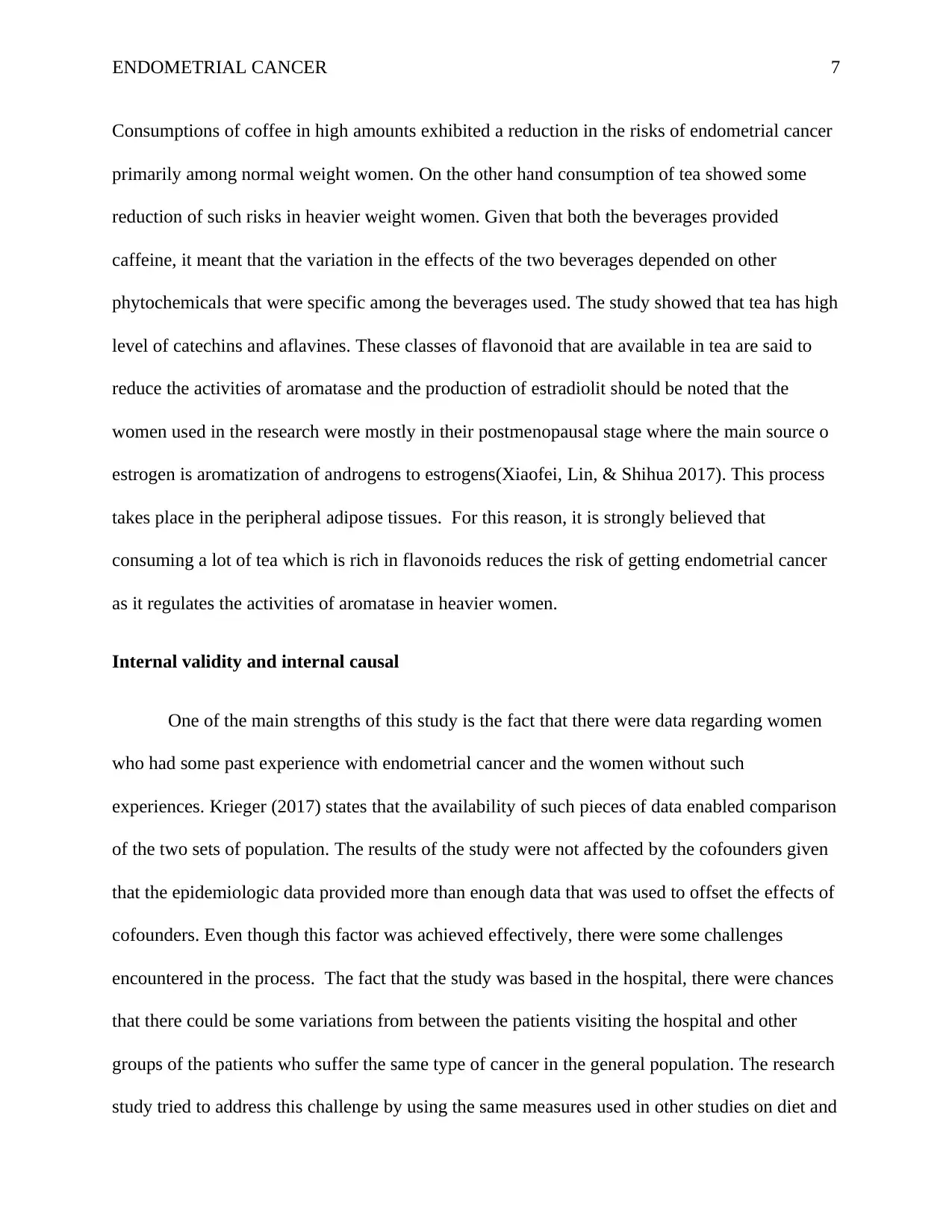
ENDOMETRIAL CANCER 7
Consumptions of coffee in high amounts exhibited a reduction in the risks of endometrial cancer
primarily among normal weight women. On the other hand consumption of tea showed some
reduction of such risks in heavier weight women. Given that both the beverages provided
caffeine, it meant that the variation in the effects of the two beverages depended on other
phytochemicals that were specific among the beverages used. The study showed that tea has high
level of catechins and aflavines. These classes of flavonoid that are available in tea are said to
reduce the activities of aromatase and the production of estradiolit should be noted that the
women used in the research were mostly in their postmenopausal stage where the main source o
estrogen is aromatization of androgens to estrogens(Xiaofei, Lin, & Shihua 2017). This process
takes place in the peripheral adipose tissues. For this reason, it is strongly believed that
consuming a lot of tea which is rich in flavonoids reduces the risk of getting endometrial cancer
as it regulates the activities of aromatase in heavier women.
Internal validity and internal causal
One of the main strengths of this study is the fact that there were data regarding women
who had some past experience with endometrial cancer and the women without such
experiences. Krieger (2017) states that the availability of such pieces of data enabled comparison
of the two sets of population. The results of the study were not affected by the cofounders given
that the epidemiologic data provided more than enough data that was used to offset the effects of
cofounders. Even though this factor was achieved effectively, there were some challenges
encountered in the process. The fact that the study was based in the hospital, there were chances
that there could be some variations from between the patients visiting the hospital and other
groups of the patients who suffer the same type of cancer in the general population. The research
study tried to address this challenge by using the same measures used in other studies on diet and
Consumptions of coffee in high amounts exhibited a reduction in the risks of endometrial cancer
primarily among normal weight women. On the other hand consumption of tea showed some
reduction of such risks in heavier weight women. Given that both the beverages provided
caffeine, it meant that the variation in the effects of the two beverages depended on other
phytochemicals that were specific among the beverages used. The study showed that tea has high
level of catechins and aflavines. These classes of flavonoid that are available in tea are said to
reduce the activities of aromatase and the production of estradiolit should be noted that the
women used in the research were mostly in their postmenopausal stage where the main source o
estrogen is aromatization of androgens to estrogens(Xiaofei, Lin, & Shihua 2017). This process
takes place in the peripheral adipose tissues. For this reason, it is strongly believed that
consuming a lot of tea which is rich in flavonoids reduces the risk of getting endometrial cancer
as it regulates the activities of aromatase in heavier women.
Internal validity and internal causal
One of the main strengths of this study is the fact that there were data regarding women
who had some past experience with endometrial cancer and the women without such
experiences. Krieger (2017) states that the availability of such pieces of data enabled comparison
of the two sets of population. The results of the study were not affected by the cofounders given
that the epidemiologic data provided more than enough data that was used to offset the effects of
cofounders. Even though this factor was achieved effectively, there were some challenges
encountered in the process. The fact that the study was based in the hospital, there were chances
that there could be some variations from between the patients visiting the hospital and other
groups of the patients who suffer the same type of cancer in the general population. The research
study tried to address this challenge by using the same measures used in other studies on diet and
Paraphrase This Document
Need a fresh take? Get an instant paraphrase of this document with our AI Paraphraser
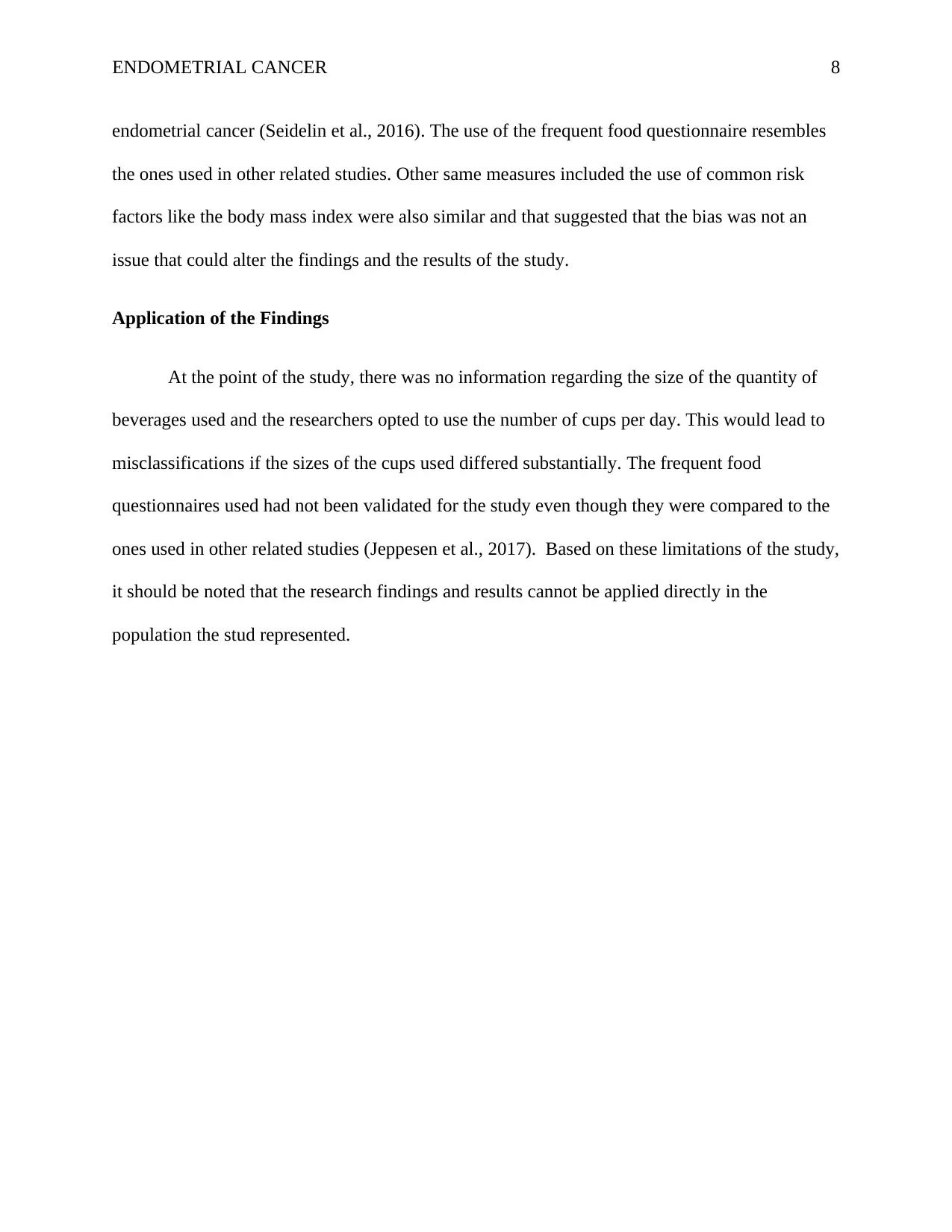
ENDOMETRIAL CANCER 8
endometrial cancer (Seidelin et al., 2016). The use of the frequent food questionnaire resembles
the ones used in other related studies. Other same measures included the use of common risk
factors like the body mass index were also similar and that suggested that the bias was not an
issue that could alter the findings and the results of the study.
Application of the Findings
At the point of the study, there was no information regarding the size of the quantity of
beverages used and the researchers opted to use the number of cups per day. This would lead to
misclassifications if the sizes of the cups used differed substantially. The frequent food
questionnaires used had not been validated for the study even though they were compared to the
ones used in other related studies (Jeppesen et al., 2017). Based on these limitations of the study,
it should be noted that the research findings and results cannot be applied directly in the
population the stud represented.
endometrial cancer (Seidelin et al., 2016). The use of the frequent food questionnaire resembles
the ones used in other related studies. Other same measures included the use of common risk
factors like the body mass index were also similar and that suggested that the bias was not an
issue that could alter the findings and the results of the study.
Application of the Findings
At the point of the study, there was no information regarding the size of the quantity of
beverages used and the researchers opted to use the number of cups per day. This would lead to
misclassifications if the sizes of the cups used differed substantially. The frequent food
questionnaires used had not been validated for the study even though they were compared to the
ones used in other related studies (Jeppesen et al., 2017). Based on these limitations of the study,
it should be noted that the research findings and results cannot be applied directly in the
population the stud represented.
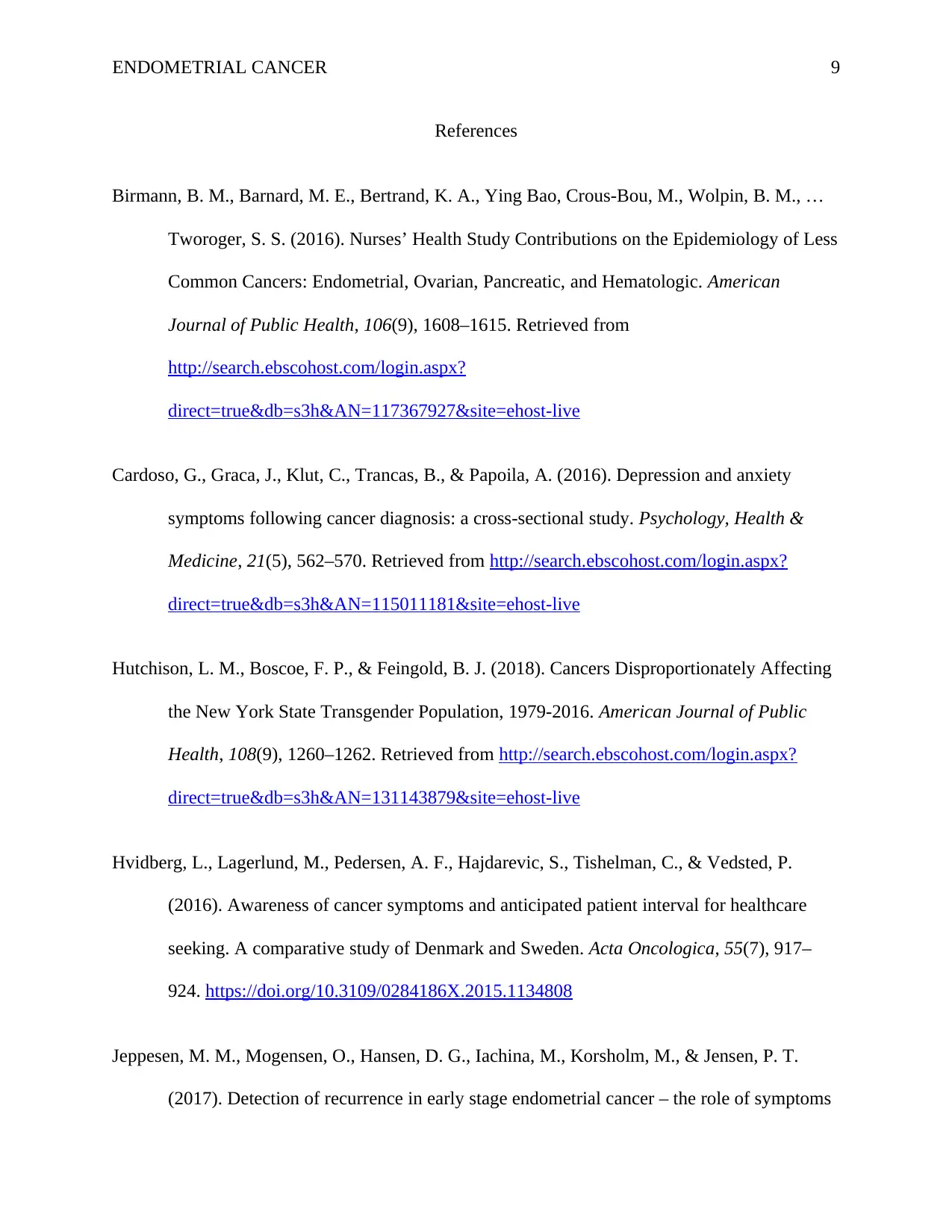
ENDOMETRIAL CANCER 9
References
Birmann, B. M., Barnard, M. E., Bertrand, K. A., Ying Bao, Crous-Bou, M., Wolpin, B. M., …
Tworoger, S. S. (2016). Nurses’ Health Study Contributions on the Epidemiology of Less
Common Cancers: Endometrial, Ovarian, Pancreatic, and Hematologic. American
Journal of Public Health, 106(9), 1608–1615. Retrieved from
http://search.ebscohost.com/login.aspx?
direct=true&db=s3h&AN=117367927&site=ehost-live
Cardoso, G., Graca, J., Klut, C., Trancas, B., & Papoila, A. (2016). Depression and anxiety
symptoms following cancer diagnosis: a cross-sectional study. Psychology, Health &
Medicine, 21(5), 562–570. Retrieved from http://search.ebscohost.com/login.aspx?
direct=true&db=s3h&AN=115011181&site=ehost-live
Hutchison, L. M., Boscoe, F. P., & Feingold, B. J. (2018). Cancers Disproportionately Affecting
the New York State Transgender Population, 1979-2016. American Journal of Public
Health, 108(9), 1260–1262. Retrieved from http://search.ebscohost.com/login.aspx?
direct=true&db=s3h&AN=131143879&site=ehost-live
Hvidberg, L., Lagerlund, M., Pedersen, A. F., Hajdarevic, S., Tishelman, C., & Vedsted, P.
(2016). Awareness of cancer symptoms and anticipated patient interval for healthcare
seeking. A comparative study of Denmark and Sweden. Acta Oncologica, 55(7), 917–
924. https://doi.org/10.3109/0284186X.2015.1134808
Jeppesen, M. M., Mogensen, O., Hansen, D. G., Iachina, M., Korsholm, M., & Jensen, P. T.
(2017). Detection of recurrence in early stage endometrial cancer – the role of symptoms
References
Birmann, B. M., Barnard, M. E., Bertrand, K. A., Ying Bao, Crous-Bou, M., Wolpin, B. M., …
Tworoger, S. S. (2016). Nurses’ Health Study Contributions on the Epidemiology of Less
Common Cancers: Endometrial, Ovarian, Pancreatic, and Hematologic. American
Journal of Public Health, 106(9), 1608–1615. Retrieved from
http://search.ebscohost.com/login.aspx?
direct=true&db=s3h&AN=117367927&site=ehost-live
Cardoso, G., Graca, J., Klut, C., Trancas, B., & Papoila, A. (2016). Depression and anxiety
symptoms following cancer diagnosis: a cross-sectional study. Psychology, Health &
Medicine, 21(5), 562–570. Retrieved from http://search.ebscohost.com/login.aspx?
direct=true&db=s3h&AN=115011181&site=ehost-live
Hutchison, L. M., Boscoe, F. P., & Feingold, B. J. (2018). Cancers Disproportionately Affecting
the New York State Transgender Population, 1979-2016. American Journal of Public
Health, 108(9), 1260–1262. Retrieved from http://search.ebscohost.com/login.aspx?
direct=true&db=s3h&AN=131143879&site=ehost-live
Hvidberg, L., Lagerlund, M., Pedersen, A. F., Hajdarevic, S., Tishelman, C., & Vedsted, P.
(2016). Awareness of cancer symptoms and anticipated patient interval for healthcare
seeking. A comparative study of Denmark and Sweden. Acta Oncologica, 55(7), 917–
924. https://doi.org/10.3109/0284186X.2015.1134808
Jeppesen, M. M., Mogensen, O., Hansen, D. G., Iachina, M., Korsholm, M., & Jensen, P. T.
(2017). Detection of recurrence in early stage endometrial cancer – the role of symptoms
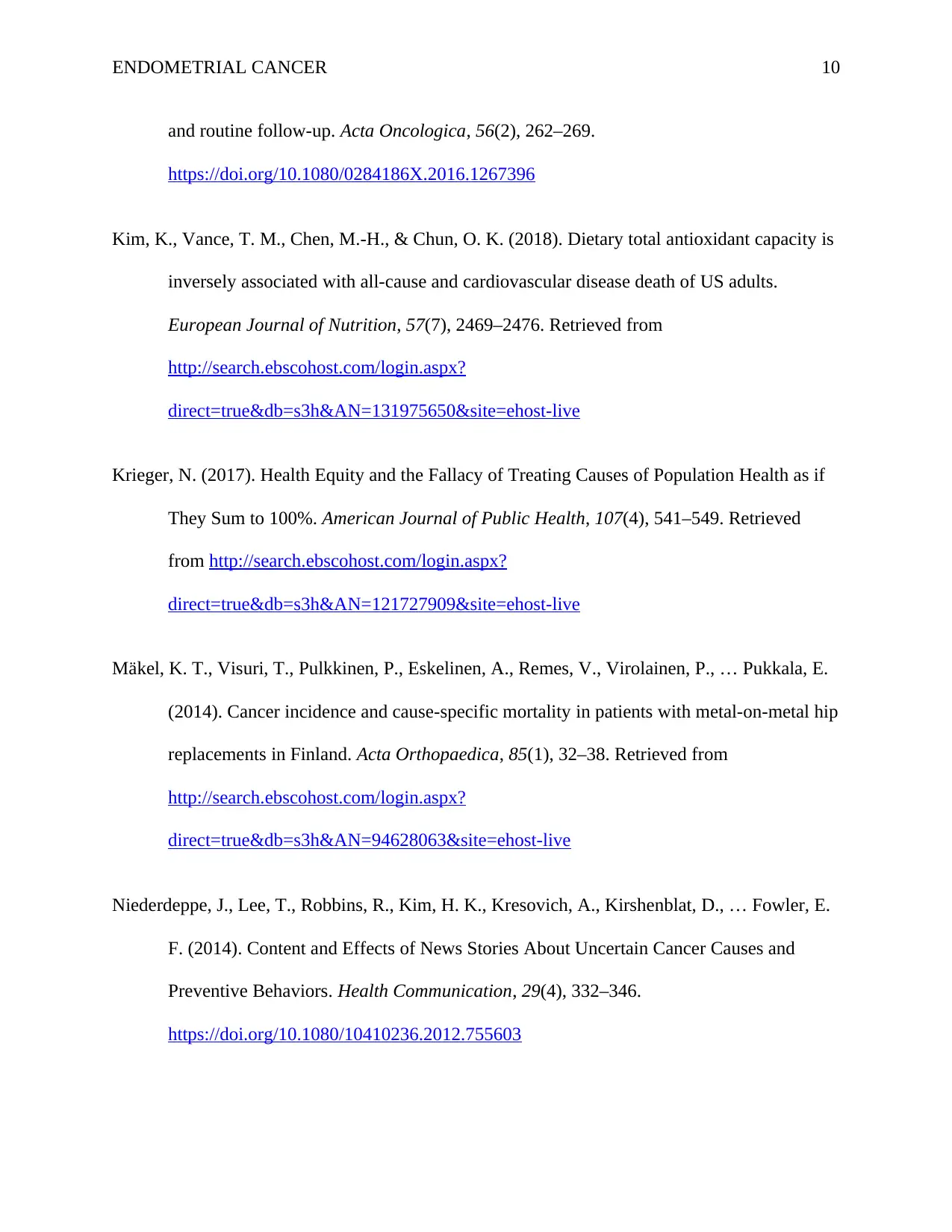
ENDOMETRIAL CANCER 10
and routine follow-up. Acta Oncologica, 56(2), 262–269.
https://doi.org/10.1080/0284186X.2016.1267396
Kim, K., Vance, T. M., Chen, M.-H., & Chun, O. K. (2018). Dietary total antioxidant capacity is
inversely associated with all-cause and cardiovascular disease death of US adults.
European Journal of Nutrition, 57(7), 2469–2476. Retrieved from
http://search.ebscohost.com/login.aspx?
direct=true&db=s3h&AN=131975650&site=ehost-live
Krieger, N. (2017). Health Equity and the Fallacy of Treating Causes of Population Health as if
They Sum to 100%. American Journal of Public Health, 107(4), 541–549. Retrieved
from http://search.ebscohost.com/login.aspx?
direct=true&db=s3h&AN=121727909&site=ehost-live
Mäkel, K. T., Visuri, T., Pulkkinen, P., Eskelinen, A., Remes, V., Virolainen, P., … Pukkala, E.
(2014). Cancer incidence and cause-specific mortality in patients with metal-on-metal hip
replacements in Finland. Acta Orthopaedica, 85(1), 32–38. Retrieved from
http://search.ebscohost.com/login.aspx?
direct=true&db=s3h&AN=94628063&site=ehost-live
Niederdeppe, J., Lee, T., Robbins, R., Kim, H. K., Kresovich, A., Kirshenblat, D., … Fowler, E.
F. (2014). Content and Effects of News Stories About Uncertain Cancer Causes and
Preventive Behaviors. Health Communication, 29(4), 332–346.
https://doi.org/10.1080/10410236.2012.755603
and routine follow-up. Acta Oncologica, 56(2), 262–269.
https://doi.org/10.1080/0284186X.2016.1267396
Kim, K., Vance, T. M., Chen, M.-H., & Chun, O. K. (2018). Dietary total antioxidant capacity is
inversely associated with all-cause and cardiovascular disease death of US adults.
European Journal of Nutrition, 57(7), 2469–2476. Retrieved from
http://search.ebscohost.com/login.aspx?
direct=true&db=s3h&AN=131975650&site=ehost-live
Krieger, N. (2017). Health Equity and the Fallacy of Treating Causes of Population Health as if
They Sum to 100%. American Journal of Public Health, 107(4), 541–549. Retrieved
from http://search.ebscohost.com/login.aspx?
direct=true&db=s3h&AN=121727909&site=ehost-live
Mäkel, K. T., Visuri, T., Pulkkinen, P., Eskelinen, A., Remes, V., Virolainen, P., … Pukkala, E.
(2014). Cancer incidence and cause-specific mortality in patients with metal-on-metal hip
replacements in Finland. Acta Orthopaedica, 85(1), 32–38. Retrieved from
http://search.ebscohost.com/login.aspx?
direct=true&db=s3h&AN=94628063&site=ehost-live
Niederdeppe, J., Lee, T., Robbins, R., Kim, H. K., Kresovich, A., Kirshenblat, D., … Fowler, E.
F. (2014). Content and Effects of News Stories About Uncertain Cancer Causes and
Preventive Behaviors. Health Communication, 29(4), 332–346.
https://doi.org/10.1080/10410236.2012.755603
Secure Best Marks with AI Grader
Need help grading? Try our AI Grader for instant feedback on your assignments.
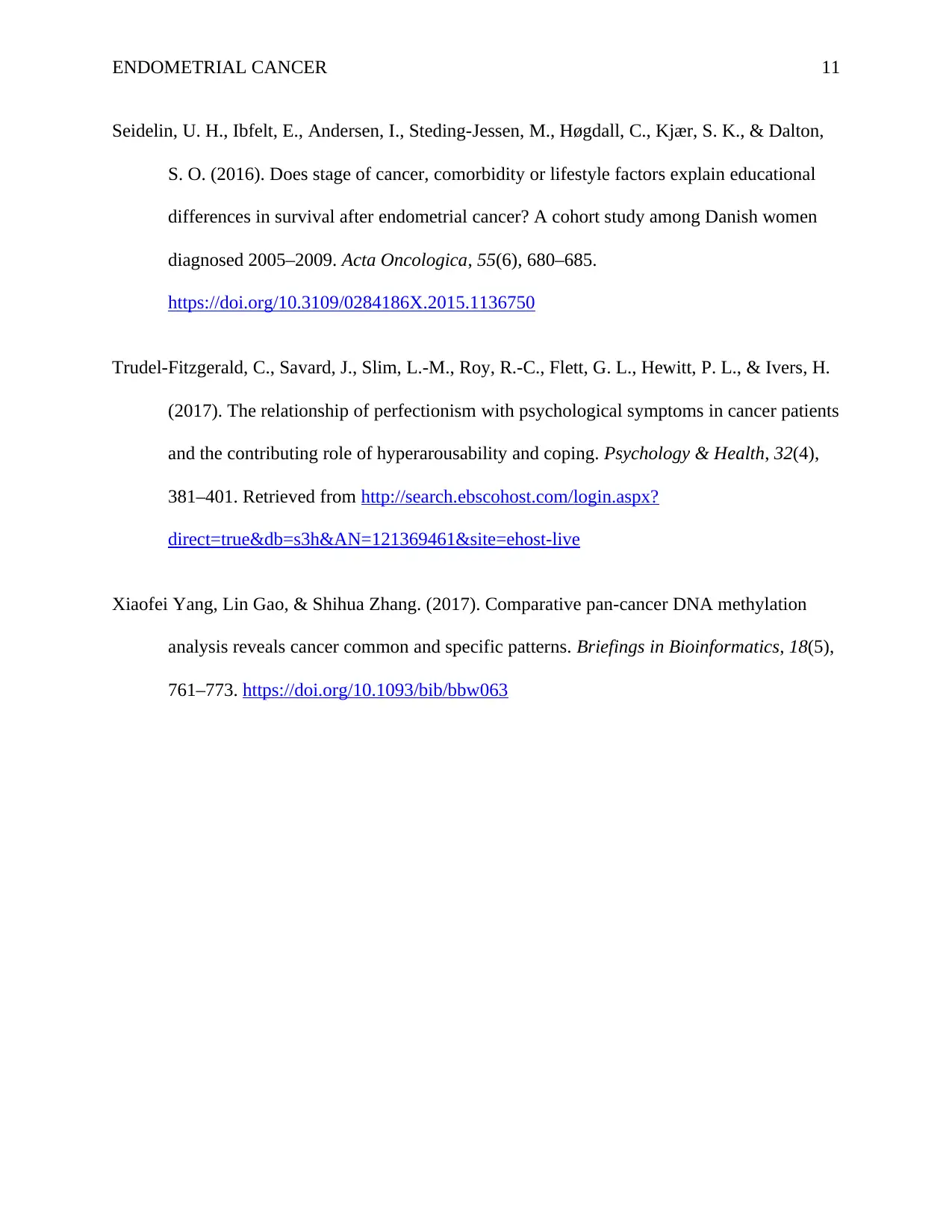
ENDOMETRIAL CANCER 11
Seidelin, U. H., Ibfelt, E., Andersen, I., Steding-Jessen, M., Høgdall, C., Kjær, S. K., & Dalton,
S. O. (2016). Does stage of cancer, comorbidity or lifestyle factors explain educational
differences in survival after endometrial cancer? A cohort study among Danish women
diagnosed 2005–2009. Acta Oncologica, 55(6), 680–685.
https://doi.org/10.3109/0284186X.2015.1136750
Trudel-Fitzgerald, C., Savard, J., Slim, L.-M., Roy, R.-C., Flett, G. L., Hewitt, P. L., & Ivers, H.
(2017). The relationship of perfectionism with psychological symptoms in cancer patients
and the contributing role of hyperarousability and coping. Psychology & Health, 32(4),
381–401. Retrieved from http://search.ebscohost.com/login.aspx?
direct=true&db=s3h&AN=121369461&site=ehost-live
Xiaofei Yang, Lin Gao, & Shihua Zhang. (2017). Comparative pan-cancer DNA methylation
analysis reveals cancer common and specific patterns. Briefings in Bioinformatics, 18(5),
761–773. https://doi.org/10.1093/bib/bbw063
Seidelin, U. H., Ibfelt, E., Andersen, I., Steding-Jessen, M., Høgdall, C., Kjær, S. K., & Dalton,
S. O. (2016). Does stage of cancer, comorbidity or lifestyle factors explain educational
differences in survival after endometrial cancer? A cohort study among Danish women
diagnosed 2005–2009. Acta Oncologica, 55(6), 680–685.
https://doi.org/10.3109/0284186X.2015.1136750
Trudel-Fitzgerald, C., Savard, J., Slim, L.-M., Roy, R.-C., Flett, G. L., Hewitt, P. L., & Ivers, H.
(2017). The relationship of perfectionism with psychological symptoms in cancer patients
and the contributing role of hyperarousability and coping. Psychology & Health, 32(4),
381–401. Retrieved from http://search.ebscohost.com/login.aspx?
direct=true&db=s3h&AN=121369461&site=ehost-live
Xiaofei Yang, Lin Gao, & Shihua Zhang. (2017). Comparative pan-cancer DNA methylation
analysis reveals cancer common and specific patterns. Briefings in Bioinformatics, 18(5),
761–773. https://doi.org/10.1093/bib/bbw063
1 out of 11
Related Documents
Your All-in-One AI-Powered Toolkit for Academic Success.
+13062052269
info@desklib.com
Available 24*7 on WhatsApp / Email
![[object Object]](/_next/static/media/star-bottom.7253800d.svg)
Unlock your academic potential
© 2024 | Zucol Services PVT LTD | All rights reserved.





